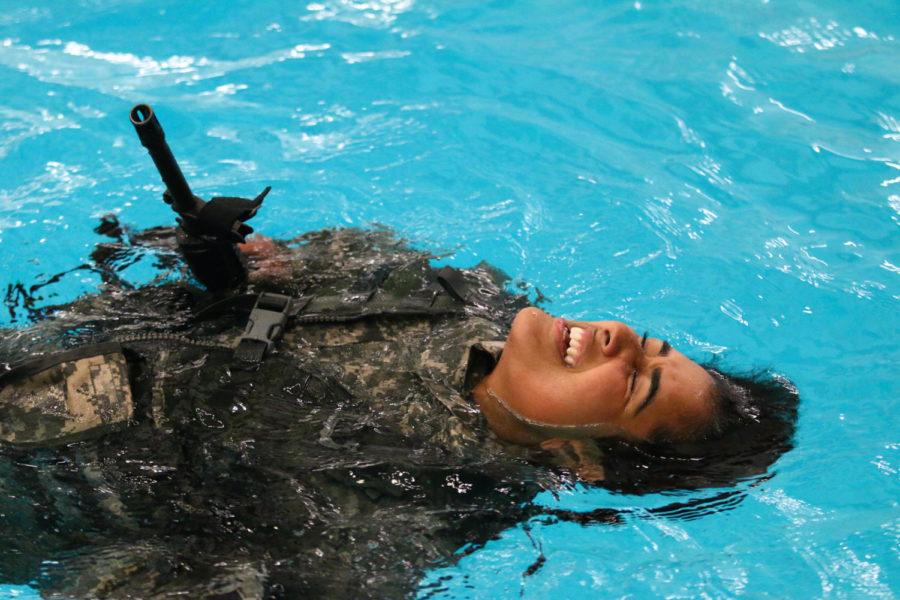AROTC cadets complete annual water survival training
November 18, 2015
Breathe in, breath out, swim.
About 140 Army ROTC cadets filled the swimming pool in Beyer Hall at 7 p.m. Wednesday for their annual fall combat water survival training.
As the cadets entered the pool area from the south hallway of Beyer, Benjamin Rurup, senior in history, asked that they line up into two rows for a quick safety and in brief.
Cadets were instructed to not horseplay, push each other around or dive into the pool. If a cadet failed to follow any of the instructions or cheated in one of the stations, he or she was to be pulled aside and had to complete the water training alone.
Nationally required of every AROTC cadet to participate in the operation, the training acts as a commissioning requirement before a cadet can graduate and become an officer in the Army.
Rurup noted that the fall training, which is offered twice a year, is provided to complete the training and meet the requirements, while the spring training provides a “more fun” take on the experience.
The outcome of the training, according to a PowerPoint at the event, is that the “Cyclone Battalion Cadets will develop adaptability, initiative and comprehensive fitness,” through the operation.
After running through the brief, the four platoons divided into their respective stations, which consisted of a five-minute water tread, a 10-minute continuous swim, an underwater equipment ditch, a 15-meter swim with gear and a three-meter blindfolded drop.
“Our cadets will be in full uniform this whole time, so just imagine swimming with long sleeve pants on and everything,” Rurup said.
Contracted cadets were required to wear their full uniforms, and non-contracted cadets were required to wear their red uniform shirts and gym shorts.
With each of the stations having their own use, the 10-minute continuous swim station was a test of endurance and stamina, while the 15-meter swim stimulated crossing a river or creek during combat.
For the underwater equipment ditch or gear drop, cadets were required to jump into the pool with their rifle and load-bearing equipment. While underwater, they were to remove all of the equipment off of their body before coming back up.
“We put a helmet and a vest on them and they have their weapon. We push them to stimulate a ‘crash’ or something like that,” Rurup said.
When it came time for cadets to do the 3-meter blindfolded drop, they were instructed to put on a gray hat and jump off at their own pace. Some cadets walked cautiously to the end of the board as they were unsure of the moment they would hit the water.
Five weeks before the actual training, cadets had been divided into smaller groups of approximately 30 people, where they ran through various trainings in the pool, Rurup said.
This is so cadets who may identify as weak swimmers are provided the training and practice to pass the training. If any cadets fail the training, they are available to try again in the spring.
Three lifeguards were present for the event, just in case any of the cadets fell into trouble.
The senior cadets acted as trainers, recorders and demonstrators for the training, as they had already completed the training in years past.
Rurup also noted the benefits of the water training.
“It’s a fun thing, and it also provides skills you need as a leader or soldier,” Rurup said. “If you have the experience beforehand you won’t freak out if it happens to you in real life.”
Not only that but it can be a source of enjoyment as well.
“[The training] helps us [because it’s] kind of a confidence builder and fun stress reliever before break,” Rurup said. “This time of the year everyone’s tired, grouchy, ready for the semester to be done and this is one of our more fun labs, where cadets can get a release and quality training.”

















